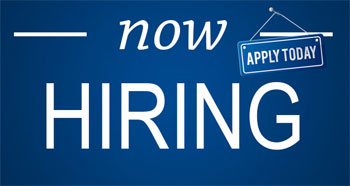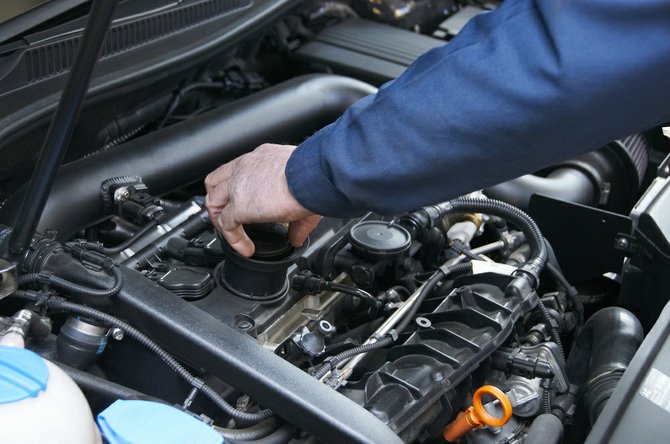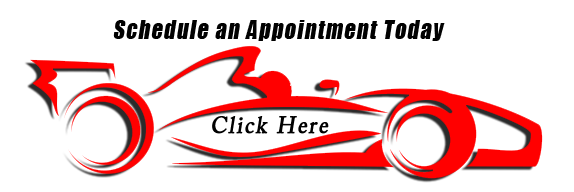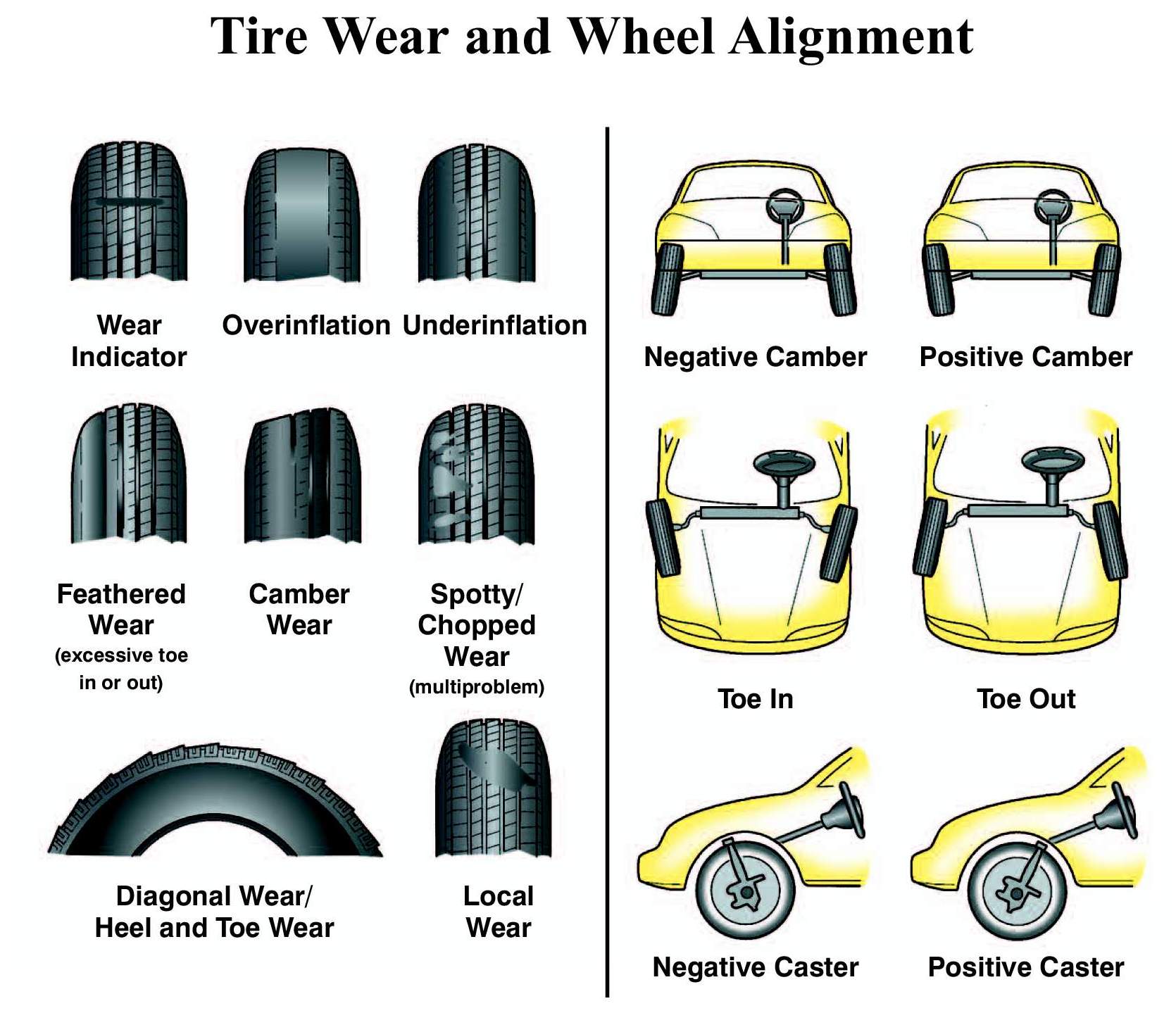 In its most basic form, wheel alignment entails adjusting the angles of the wheels
In its most basic form, wheel alignment entails adjusting the angles of the wheels
This article begins with information that every driver should know; however, if you want to learn more about this topic, click on the underlined words for more detailed explanations of each term. We will go over various levels of detail, with the most in-depth levels containing information that even a wheel alignment technician will find useful.
Wheel Alignment is frequently confused with Wheel Balancing. The only thing they have in common is that they affect ride and handling. If a wheel is out of balance, it will cause a vibration at highway speeds that can be felt in the steering wheel and/or the seat. Excessive tire wear and steering or tracking issues can result from a misaligned vehicle.
Camber, Caster and Toe-in
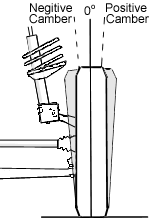 Camber is the angle of the wheel, measured in degrees, when viewed from the front of the vehicle. If the top of the wheel is leaning out from the center of the car, then the camber is positive ,if it's leaning in, then the camber is negative. If the camber is out of adjustment, it will cause tire wear on one side of the tire's tread. If the camber is too far negative, for instance, then the tire will wear on the inside of the tread.
Camber is the angle of the wheel, measured in degrees, when viewed from the front of the vehicle. If the top of the wheel is leaning out from the center of the car, then the camber is positive ,if it's leaning in, then the camber is negative. If the camber is out of adjustment, it will cause tire wear on one side of the tire's tread. If the camber is too far negative, for instance, then the tire will wear on the inside of the tread.

If the camber is different from side to side it can cause a pulling problem. The vehicle will pull to the side with the more positive camber. On many front-wheel-drive vehicles, camber is not adjustable. If the camber is out on these cars, it indicates that something is worn or bent, possibly from an accident and must be repaired or replaced.
Caster
 When you turn the steering wheel, the front wheels respond by turning on a pivot attached to the suspension system. Caster is the angle of this steering pivot, measured in degrees, when viewed from the side of the vehicle. If the top of the pivot is leaning toward the rear of the car, then the caster is positive, if it is leaning toward the front, it is negative. If the caster is out of adjustment, it can cause problems in straight line tracking. If the caster is different from side to side, the vehicle will pull to the side with the less positive caster. If the caster is equal but too negative, the steering will be light and the vehicle will wander and be difficult to keep in a straight line. If the caster is equal but too positive, the steering will be heavy and the steering wheel may kick when you hit a bump. Caster has little affect on tire wear.
When you turn the steering wheel, the front wheels respond by turning on a pivot attached to the suspension system. Caster is the angle of this steering pivot, measured in degrees, when viewed from the side of the vehicle. If the top of the pivot is leaning toward the rear of the car, then the caster is positive, if it is leaning toward the front, it is negative. If the caster is out of adjustment, it can cause problems in straight line tracking. If the caster is different from side to side, the vehicle will pull to the side with the less positive caster. If the caster is equal but too negative, the steering will be light and the vehicle will wander and be difficult to keep in a straight line. If the caster is equal but too positive, the steering will be heavy and the steering wheel may kick when you hit a bump. Caster has little affect on tire wear.
 The best way to visualize caster is to picture a shopping cart caster. The pivot of this type of caster, while not at an angle, intersects the ground ahead of the wheel contact patch. When the wheel is behind the pivot at the point where it contacts the ground, it is in positive caster. Picture yourself trying to push the cart and keep the wheel ahead of the pivot. The wheel will continually try to turn from straight ahead. That is what happens when a car has the caster set too far negative. Like camber, on many front-wheel-drive vehicles, caster is not adjustable. If the caster is out on these cars, it indicates that something is worn or bent, possibly from an accident, and must be repaired or replaced.
The best way to visualize caster is to picture a shopping cart caster. The pivot of this type of caster, while not at an angle, intersects the ground ahead of the wheel contact patch. When the wheel is behind the pivot at the point where it contacts the ground, it is in positive caster. Picture yourself trying to push the cart and keep the wheel ahead of the pivot. The wheel will continually try to turn from straight ahead. That is what happens when a car has the caster set too far negative. Like camber, on many front-wheel-drive vehicles, caster is not adjustable. If the caster is out on these cars, it indicates that something is worn or bent, possibly from an accident, and must be repaired or replaced.
Toe-In
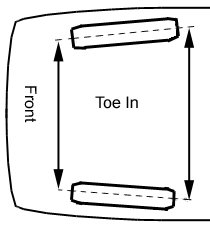 The toe measurement is the difference in the distance between the front of the tires and the back of the tires. It is measured in fractions of an inch in the US and is usually set close to zero which means that the wheels are parallel with each other. Toe-in means that the fronts of the tires are closer to each other than the rears. Toe-out is just the opposite. An incorrect toe-in will cause rapid tire wear to both tires equally. This type of tire wear is called a saw-tooth wear pattern as shown in this illustration.
The toe measurement is the difference in the distance between the front of the tires and the back of the tires. It is measured in fractions of an inch in the US and is usually set close to zero which means that the wheels are parallel with each other. Toe-in means that the fronts of the tires are closer to each other than the rears. Toe-out is just the opposite. An incorrect toe-in will cause rapid tire wear to both tires equally. This type of tire wear is called a saw-tooth wear pattern as shown in this illustration.

If the sharp edges of the tread sections are pointing to the center of the car, then there is too much toe-in. If they are pointed to the outside of the car then there is too much toe-out. Toe is always adjustable on the front wheels and on some cars, is also adjustable for the rear wheels.
Four-Wheel Alignments
There are two main types of 4-wheel alignments. In each case, the technician will place an instrument on all four wheels. In the first type the rear toe and tracking is checked, but all adjustments are made at the front wheels. This is done on vehicles that do not have adjustments on the rear. The second type is a full 4-wheel alignment where the adjustments are first made to true up the rear alignment, then the front is adjusted. A full 4-wheel alignment will cost more than the other type because there is more work involved.
Other facts every driver should know about wheel alignments.
 A proper wheel alignment should always start and end with a test drive.
A proper wheel alignment should always start and end with a test drive.- The front end and steering linkage should be checked for wear before performing an alignment.
- The tires should all be in good shape with even wear patterns. If you have a tire with excessive camber wear, for instance, and you correct the alignment problem that caused that wear, the tire will now be making only partial contact with the road. (see illustration on right)
- Pulling problems are not always related to wheel alignment. Problems with tires (especially unequal air pressure), brakes and power steering can also be responsible. It is up to a good wheel alignment technician to determine the cause.

